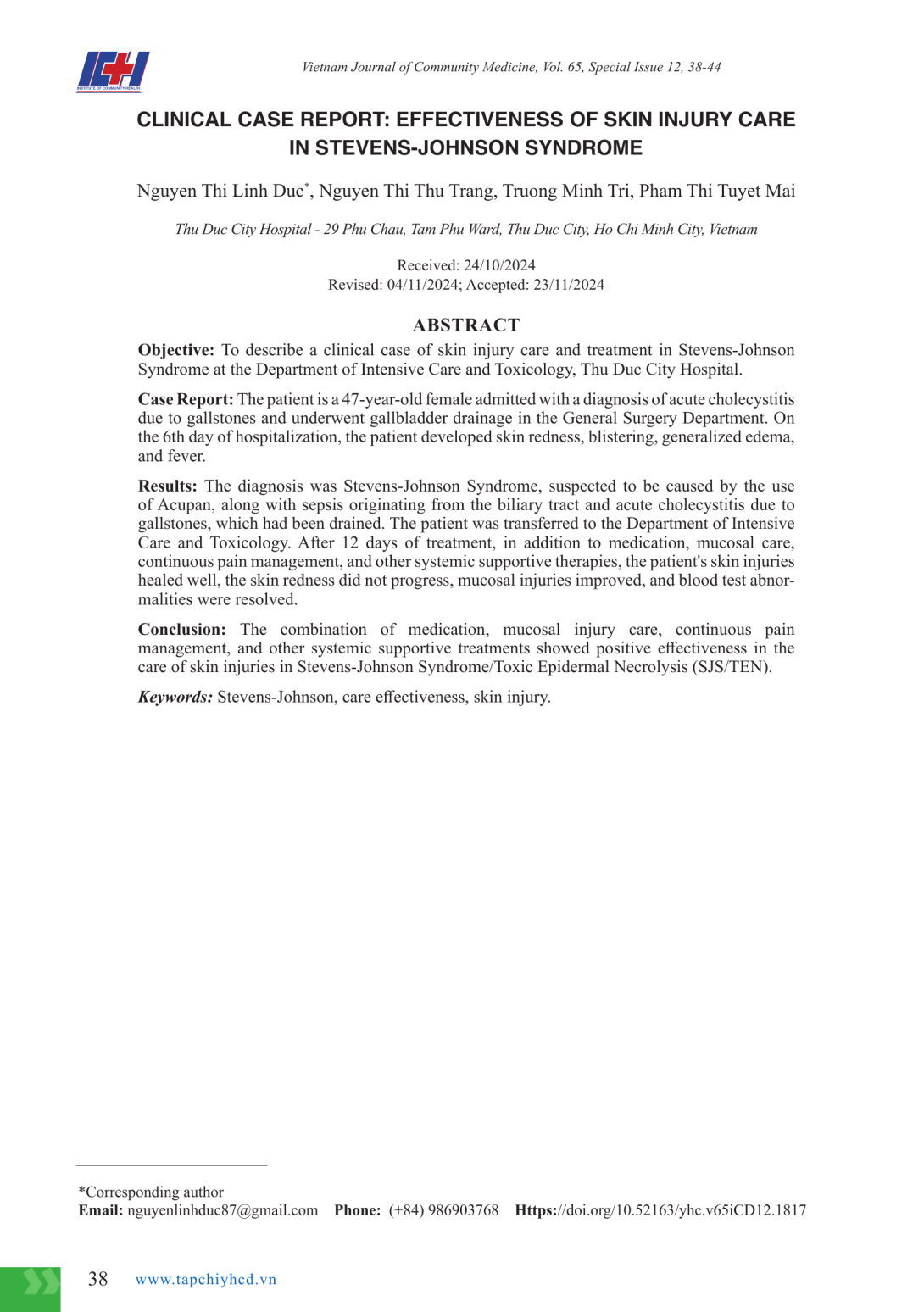
Mô tả một trường hợp lâm sàng về chăm sóc và điều trị tổn thương da trong hội chứng Steven-Johnson tại khoa Hồi sức tích cực chống độc, bệnh viện Thành phố Thủ Đức. Ca bệnh: Người bệnh là nữ 47 tuổi, nhập viện với chẩn đoán viêm túi mật cấp do sỏi, được dẫn lưu túi mật tại khoa Ngoại tổng quát. Ngày thứ 6 sau nhập viện, người bệnh có tình trạng đỏ da nổi bóng nước, phù toàn thân, sốt. Kết quả: Hội chứng Stevens-Johnson nghi do sử dụng thuốc Acupan - NT huyết từ đường mật – Viêm TM cấp do sỏi đã dẫn lưu. NB được chuyển khoa HSTCCĐ. Sau 12 ngày điều trị, ngoài việc sử dụng phác đồ dùng thuốc, chăm sóc các tổn thương niêm mạc, áp dụng các biện pháp giảm đau liên tục cùng với các điều trị hỗ trợ toàn thân khác thì tổn thương da lành tốt, không đỏ da tiến triển, các tổn thương niêm mạc cải thiện cũng như các rối loạn về xét nghiệm máu của bệnh nhân đã hết. Kết luận: Việc phối hợp dùng thuốc, chăm sóc các tổn thương niêm mạc, áp dụng các biện pháp giảm đau liên tục cùng với các điều trị hỗ trợ toàn thân là có hiệu quả tích cực trong quá trình chăm sóc tổn thương da trong Hội chứng Stevens-Johnson/Lyell (SJS/TEN).
To describe a clinical case of skin injury care and treatment in Stevens-Johnson Syndrome at the Department of Intensive Care and Toxicology, Thu Duc City Hospital.Case Report: The patient is a 47-year-old female admitted with a diagnosis of acute cholecystitis due to gallstones and underwent gallbladder drainage in the General Surgery Department. On the 6th day of hospitalization, the patient developed skin redness, blistering, generalized edema, and fever. Results: The diagnosis was Stevens-Johnson Syndrome, suspected to be caused by the use of Acupan, along with sepsis originating from the biliary tract and acute cholecystitis due to gallstones, which had been drained. The patient was transferred to the Department of Intensive Care and Toxicology. After 12 days of treatment, in addition to medication, mucosal care, continuous pain management, and other systemic supportive therapies, the patient's skin injuries healed well, the skin redness did not progress, mucosal injuries improved, and blood test abnor-malities were resolved.Conclusion: The combination of medication, mucosal injury care, continuous pain management, and other systemic supportive treatments showed positive effectiveness in the care of skin injuries in Stevens-Johnson Syndrome/Toxic Epidermal Necrolysis (SJS/TEN).
- Đăng nhập để gửi ý kiến
